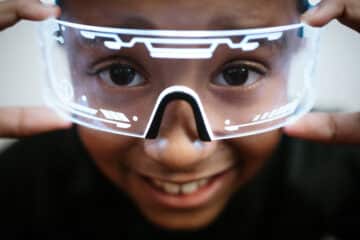
Source: OECD. (February 2011). PISA in Focus 1: Does participation in pre-primary education translate into better learning outcomes at school?)
The new report, Starting well, by the Economist Intelligence Unit (EIU) and the Lien Foundation profiled in our Global Perspectives section this month urges the importance of having strong early childhood education systems in place in order to ensure future success in school. The OECD provides data that backs up this assertion in a 2011 PISA in Focus brief, Does participation in pre-primary education translate into better learning outcomes at school?, which outlines the correlation between participation in pre-primary education and later PISA performance. The OECD defines pre-primary education as different from preschool – this category encompasses “all forms of organized and sustained center-based activities,” including both preschools and daycare centers, so their definition is somewhat different from that in Starting well, which makes a clearer distinction between daycare and preschool. The data is unequivocal. After accounting for socio-economic background, they found that students who attended more than one year of pre-primary education had, on average, a 33 point advantage on PISA over students who had not attended pre-primary education for more than a year. The average difference between students who had attended for more than one year and students who had not attended at all was even higher, at 54 points on the reading portion of the test. With 39 PISA points being equivalent to a year of schooling, this difference is quite significant. Of the 65 countries participating in PISA, students attending more than a year of pre-primary education had at least a small advantage over students who did not in all but one case.
Some countries have a particularly large gap on PISA; in France, Belgium and Israel, the gap between students from similar backgrounds ranges from about 60 to 80 points. And the brief’s authors found that when socioeconomic status was not taken into account – that is, when all students who attended pre-primary school for more than a year were simply compared to all students who had not – there was an even greater gap of more than 100 points in all three cases. This is perhaps unsurprising in the case of Belgium and France, given that these two countries rank highly on the Starting well index, and Belgium is in fact ranked first in the world in terms of availability of early childhood education. If a country has a high quality, widely available preschool system, it is not surprising that students who did not take advantage of that system would fare poorly compared to their classmates who had.
The OECD data lends credence to the assertion by the Starting well authors that inclusion is one of the most important factors of a strong preschool system. Not only does the system need to be high-quality, it must be available to all children in order to raise the entire student population’s educational performance; according to the OECD, the correlation between PISA performance and pre-primary attendance is highest in countries that provide more access to pre-primary education. Furthermore, in many of the countries, the brief finds, participation in early childhood education is more effective for immigrant students in closing the performance gap than for native students. On this front, the authors of Starting well investigated whether countries with greater income equality were more likely to have an affordable preschool system. They plotted each country’s affordability ranking with its Gini coefficient, which we have recreated below. The Gini coefficient is a measure of a country’s income equality, expressed either as a number between 0 and 100. A country with a Gini coefficient of 0 has perfect income equality, while a country with a Gini coefficient of 100 has perfect income inequality. The report’s authors found that countries with greater affordability in early childhood education were also more likely to have greater income equality (figure 1). However, affordability was not the only aspect of early childhood education ranked by the Economist Intelligence Unit. In addition to affordability, the Economist Intelligence Unit also ranks countries’ early childhood education systems in terms of quality and availability, and produces an overall ranking that takes all three of these categories, as well as social context, into account. We plotted the availability, quality and overall rankings with the countries’ Gini coefficients in order to determine whether income equality was likely to predict these other features of an early childhood education system, as well.

Source: The Economist Intelligence Unit. (2012). Starting well: Benchmarking early education across the world.; The CIA World Factbook
Figure 2 indicates that the lower the Gini index, the higher the ranking is likely to be in terms of position in the ranking – a low ranking number means a high spot on the league table. Like affordability, quality also correlates fairly strongly to income equality (figure 3), as does availability (figure 4), though availability correlates to income equality less so than do affordability and quality. The overall ranking actually has the strongest correlation to income equality (figure 5), possibly because this ranking takes into account not just affordability, availability and quality, but also social context. Social context is measured in this case by the prevalence of malnutrition, the mortality rate of children under the age of five, the DPT immunization rate, the gender inequality index and the adult literacy rate. It follows that countries with high income equality, such as the Nordic countries and other Western European countries, would have strong rankings in these areas, while countries with a higher income inequality such as South Africa, Thailand and Mexico may not fare as well.

Source: The Economist Intelligence Unit. (2012). Starting well: Benchmarking early education across the world.; The CIA World Factbook
Notable, too, is that the countries with the greatest income equality and generally the best early childhood education systems are not the countries that spend the most on this service. Finland spends just $5,334 annually per student, well below the United States, which spends a staggering $10,070 per student per year, and is ranked solidly in the middle of the 45 countries in the Economist Intelligence Unit league tables. However, the other top-ranked countries, except Belgium, spend a little more than the OECD average on these services. Across the

Source: The Economist Intelligence Unit. (2012). Starting well: Benchmarking early education across the world.; The CIA World Factbook
OECD, countries spend on average $6,210 per student per year. The countries rounding out the top five in the overall ranking along with Finland – Sweden, the United Kingdom, Norway and Belgium – for the most part spend a little more, but not substantially so. Belgium spends just a bit more than Finland at $5,732, while Sweden, the United Kingdom and Norway spend $6,519, $7,119 and $6,572, respectively. Chile has been working hard in recent years to improve their early childhood education

Source: The Economist Intelligence Unit. (2012). Starting well: Benchmarking early education across the world.; The CIA World Factbook
programs, and is now ranked at number 20 – several spots above the United States – in the overall rankings. They spend just $3,951 per year, and have achieved their rapid improvement through expanding access (the number of preschools increased by 550% between 2006 and 2009) through public and private providers, and establishing national curriculum guidelines. While quality preschool education cannot apparently be had at incredibly low prices, it appears that social context and access are more important in building a high-quality system than spending alone.
There can be little question that early childhood education programs can provide strong educational advantages for students later in their education. But building and strengthening these programs seems to have more to do with ensuring that high proportions of children are included in them, rather than what is spent on them.




